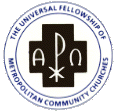In my last entry I noted that I’d been exposed to so many denominational traditions on the road to seminary that I needed to break them into two sections. Here’s the continuation…
 Metropolitan Community Churches
Metropolitan Community Churches
My first experience with the MCC opened another world to me in which gays, lesbians, bisexuals and transgendered people came together en masse to worship God. Founded by Pentecostal pastor Troy Perry, the MCC proclaims an incarnational theology that celebrates the body – including its sexuality – as God’s good gift.
For the first time I saw what it means for LGBT folks to come together, letting their queerness inform how they presented themselves before God rather than seeing sexual desires and gender identity as something to be overcome in order to be holy.
The MCC also began to teach me the meaning of a truly open table where the living Christ invites everyone to the Eucharist. No more "us" and "them," but only the "we" that are all beckoned as equals to approach the Risen One.
Episcopal Church
 In the Episcopal Church I found a people united by the Book of Common Prayer. And in their midst, I experienced the Eucharist as a sacrament in a way that I had never felt before.
In the Episcopal Church I found a people united by the Book of Common Prayer. And in their midst, I experienced the Eucharist as a sacrament in a way that I had never felt before.
I’d been raised in churches that scoffed at written liturgy as wooden and dead. But here I found the presence of God in the bread and the wine, in the prayers and balm for healing, and in the incense and flame of the Christmas and Easter services.
It was here that I started to truly appreciate liturgy as the work of the people. And finally, to love it in my heart. (And on visiting a non-liturgical congregation later I found another appreciation for the Book of Common Prayer while being held captive in a 10-minute, extemporaneous intercessory prayer – but that’s another story…![]() )
)
 Mennonite
Mennonite
Among the Mennonites I got back in touch with the meaning of discipleship as I saw my local church embody their convictions throughout the week. This wasn’t a Sunday-only religion, but a way of life that shaped their values and their actions.
It was also here, in the heart of the historic peace churches, that the message of nonviolence came home in a real way. In an earlier post I referred to my crisis of faith around atonement. It was after reading Chris Glaser’s words and finally making application to seminary that I also found, in the Mennonite Church, Girard’s mimetic theory and began to study its application as an alternative to violence.
It’s Been A Strange Journey…
On the road to seminary I participated in many different traditions — both a blessing and its own form of curse. As a result, the journey is much richer, but it has also proven difficult to find a place where I fit in. In some ways I suppose that’s not so bad. At least I’m not tempted to put all my eggs in one basket or to linger in one place past the point when the Spirit blows… In this way, it’s not really a curse at all, but a gift of God that reminds me that we’re on a journey and that our ultimate destination is not to be found in any one human institution.